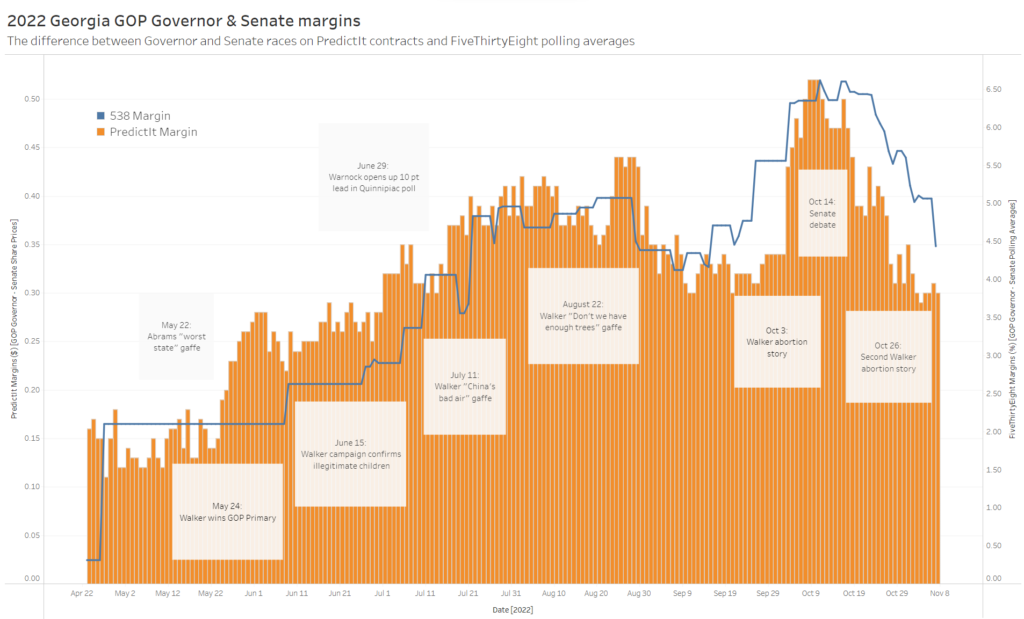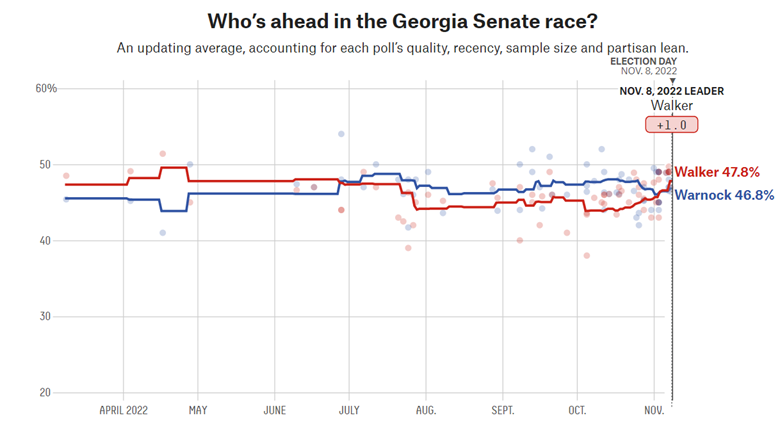One of the most fascinating states, if not the most fascinating state, in recent elections is Georgia. Historically a “red” state, Former Vice-President Joe Biden upset President Donald Trump with a plurality in 2020, while two incumbent Republican Senators were replaced with Democrats. This was the first time since January 2003 that Georgia had been represented by two Democrats in the U.S. Senate and the first time since Clinton won with a plurality in 1992 that a Democratic presidential candidate carried the state.
In the 2022 midterm elections, Georgia held two high-profile statewide races, Senate and Gubernatorial, leading to an avalanche of outside spending. In the U.S. Senate race, incumbent Democratic Senator Raphael Warnock defeated former football star Republican Herschel Walker, while in the Gubernatorial race, incumbent Republican Governor Brian Kemp defeated community activist Stacy Abrams, a rematch of the 2018 Georgia Governor’s race. Kemp won re-election on November 8th, while neither Walker nor Warnock received more than 50% of the vote, triggering a December 6th run-off election that Warnock won.
This article is not about Trump, Biden, 2020, 2024, election integrity, Democratic statewide candidates, other down-ballot races, or even the 2022 run-off election, but is looking at the gap between Kemp and Walker throughout the Tuesday, November 9, 2022, General Election. As partisanship rises, split-ticket voting continues to decline in America, but Georgia managed to produce one of the increasingly rare split election results.
In the table below, we see Kemp received roughly 203K votes more than Walker in the November 8th General Election:
| Candidate | Votes | Votes Cast | Percentage |
| Kemp | 2,111,572 | 3,953,408 | 53.4% |
| Walker | 1,908,442 | 3,935,924 | 48.5% |
| Difference | 203,130 | 17,484 | 4.9% |
Please keep in mind that those 203,130 voters who voted for Kemp but not Walker, didn’t necessarily vote for Warnock:
- There were 17,484 fewer votes cast in the Senate ballot than Gubernatorial.
- Warnock received 1,946,117 votes on November 8th (only 37,675 more than Walker)
- Chase Oliver, the Libertarian nominee in the Senate race, received 81,365 votes, which was 53,202 more votes than the Libertarian on the Gubernatorial ballot.
If Walker had received votes from 30% of those 203K ‘Kemp but not Walker’ voters, he would have won outright on November 8th.
In the chart below, we’re comparing the margins between Kemp and Walker in two ways:
- Difference in the probability of winning using PredictIt share prices. PredictIt is a prediction market that allows traders to buy and sell binary option contracts. Traders bet “Yes” or “No” on whether a political event will happen, such as “Which party will win the GA Senate race?” or “Which party will win GA governor’s race?” The share price for the Yes and No contracts can represent the probability of the event happening. In orange (left axis), we’re showing the margin between the closing share prices (i.e., probabilities) for the Republican candidate winning the Georgia Gubernatorial Senate races.
- Difference in support using FiveThirtyEight polling averages. The blue line (right axis) is the difference in the FiveThirtyEight polling averages between the Georgia Republican Gubernatorial and Senate campaigns.

The margin between Kemp and Walker in their PredictIt share prices and FiveThirtyEight polling averages were, unsurprisingly, highly correlated (r = 0.86), and seem to have been driven by various Walker gaffes throughout the campaign. The chart above annotates some (but not all, there were just too many to fit on the chart) of Walker’s various statements, scandals, and personal issues that drove negative news stories.
The PredictIt share price margin – measuring the difference in each candidate’s probability of winning – ranged from $0.11 (April 27) to $0.52 (October 8-10) per share. The FiveThirtyEight polling average margin ranged from 0.32% (April 23-26) to 6.60% (October 16-17). All the Predict and FiveThirtyEight margin values are positive, meaning that Kemp lead Walker in all data points observed.
Please keep in mind that while Walker trailed Kemp on PredictIt and FiveThirtyEight, some polling and prediction markets had Walker leading Warnock. PredictIt had Walker priced higher than Warnock at the end of November 7th (+$0.26/share) and FiveThirtyEight actually had Walker ahead of Warnock in its polling average (+1.0%):

We don’t know for certain why the gap between Kemp and Trump existed, but there are some hints. There are plenty of anecdotes from July, September, and October about split-ticket voters in Georgia. In December, Wick Insights released polling data about the Kemp-Warnock voter profile. Their data showed these voters were disproportionately white, college educated, and urban. These voters overwhelmingly approved of how Kemp handled the pandemic but at the same time disliked Trump. Over 70% were self-described moderates or “somewhat conservative.”
“Both Kemp and Warnock are in the persuasion world,” said one Republican operative.
cnn.com
Kemp kept his distance from Walker during the election; they did not campaign together until November 19th during the run-off, nearly two weeks after the General Election. At the same time, Warnock’s campaign targeted Republicans in the run-off with TV ads. Warnock ended up winning the December 6th run-off election with 51.4%, a margin of 99,389 votes.
For future analysis, it would be interesting to look at:
- The Kemp-Walker margins at the county and precinct level.
- FiveThirtyEight’s Senate model probabilities for Georgia versus their polling averages and PredictIt share prices.
- The ratio between Kemp-Walker margins in polling and share prices held consistent during the last three months of the General Election. Does this hold up in other states and races?
